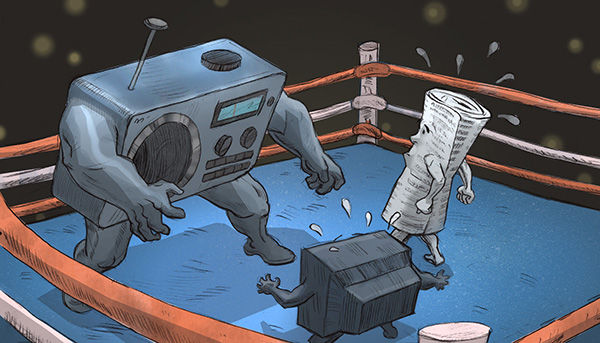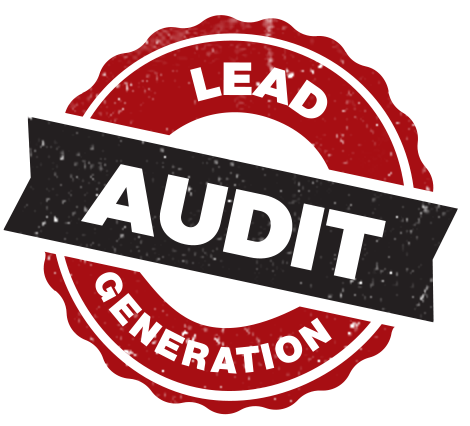If You’re Trying To Figure Out Where To Spend Your Contractor Marketing, Here’s A Quick, Concise & Objective Comparison To Help You Decide.
Let’s Get Ready To Rumble!
Written by Rich Harshaw
On Wednesday I built a pretty strong case of why radio is a great place to start your advertising FARMING campaign; if you’ haven’t read that, please do so now before continuing today.
Today I’m going to compare radio against other advertising media to help you see the relative pros and cons of each. This comparison isn’t meant to be exhaustive—it’s meant to be a good overview.
After that, at the end of this posting, I’ll answers a few radio FAQs, then you’ll be on your way.
Featherweight: Radio vs. Magazines
I can think of a million reasons to stay out of magazines, and only a couple to opt in. Here we go:
Targeting Ability: If you’re a contractor, there are not really any magazines I can think of that you should be in. The whole point of a magazine is to create extremely niched content for enthusiasts of various kinds: car magazines, running magazines, decorating magazines, etc. By definition, most of these are national in their scope. The few local magazines that exist usually are pretty flimsy editorially, and there are far more effective ways to reach that same target market. Verdict: ★
Cost: It’s all over the map—but generally pretty expensive. Possibly worth it if you’re New Balance and you want to reach runners. Probably not worth it if you’re ABC Contractor trying to reach people who want to replace their windows. Verdict: ★
Ease: Magazines tend to be monthly, so they’re pretty easy to manage. Woo hoo! Verdict: ★★★★
Farming Ability: Because magazines are monthly, there’s very little ability to consistently reach people over and over again. That doesn’t mean they won’t see (and even recognize) your ad every month, it just means that it’s a crappy way to hold a conversation with somebody. Radio wins by a mile. Verdict: ★
Best For: Advertisers who need to reach a super-niched market and can do so through a niched magazine.
Worst For: Everyone and everything else.
Overall Verdict: Radio By 1st Round Knockout
Lightweight: Radio vs. Newspaper
Newspaper gets a bad rap, and honestly, it’s for a pretty good reason. Let’s take a look at this aging veteran of advertising media:
Targeting Ability: Newspaper gives far greater geographic control than radio. That’s definitely an advantage if you’re trying to reach a specific neighborhood or get home improvement leads in certain zip codes—hyper-local businesses like restaurants, dentists, etc. But from any other kind of targeting standpoint, newspaper stinks. Naturally, it skews OLDER, but beyond that, it’s hard to separate men from women, rich from poor, older from younger, and so forth. Verdict: ★★
Cost: Those newspaper people are really proud of that paper. While local market conditions will certainly vary, newspaper tends to be pretty expensive. And I don’t trust “circulation” and “readership” statistics at all… I find them to be overinflated and unbelievable. If a newspaper rep ever tries to sell you on “readership,” turn and run away… that’s a supposed measurement of how many different people read a given paper. Verdict: ★
Ease: If you run a consistent newspaper campaign, you’re going to want to change up your ads a few times a week. Lead times are usually just a few days, so working with a graphic designer to keep fresh ads on the newspaper is pretty easy to deal with. Verdict: ★★★★
Farming Ability: There are two kinds of newspapers, generally speaking: dailies, and weeklies. Weeklies are usually smaller papers that are heavily geo-targeted—like community newspapers… that carry local high school sports stories, city council meeting minutes, and so forth. People who read these tend to read them consistently—good for consistently reaching them. Dailies tend to be bigger papers, but have the added advantage of, well, being read by people on a daily basis. This is good for reaching the same people over and over again. Verdict: ★★★★
Best For: Companies who want to reach local customers in a smaller geographic area that can be efficiently reached by radio.
Worst For: Companies who cover a wide geographic territory that can more effectively and efficiently be reached by radio. Companies who need to target prospects based on gender, income, or other demographic traits.
Overall Verdict: Radio By Knockout
Welterweight: Radio vs. Direct Mail
The USPS can’t turn a profit; jokes about “snail mail” and “going postal” are so old that Seinfeld was telling them. But the post office just keeps chugging along, serving an important role to advertisers.
Targeting Ability: Outstanding. Nothing is more precise than a well-executed direct mail campaign. You can pinpoint both geography and demographics. If you have the right tools, you can laser-focus your targeting right down to the individual household level. We have a client who sends direct mail to every single home over 12 years old with certain incomes and certain buying preferences every single month. Want to follow up your own customers? Or your own leads? Mail is the best. Want to generate leads—this can be done with careful targeting and planning. Verdict: ★★★★★
Cost: It’s expensive. A good radio buy might come in at $3.00 to $5.00 per thousand listeners. Same for TV. But direct mail is going to cost many multiples of that: If the average mail piece costs $0.50 to print and deliver (naturally, it varies… but 50 cents is pretty common), that’s an astounding $500 per thousand—100 times greater than we just discussed for radio or TV. Even at 25 cents per piece, that’s $250 per thousand. The tradeoff, of course, is your ability to target (see above) and your ability to have your mail piece seen (see “farming,” below. Verdict: ★★
Ease: Direct mail takes a lot of coordination—it’s not that easy to pull off. There’s the creative/design, of course… but then you have to consider list acquisition and print/mail coordination. These are things generally better left to professionals. Mild “do not try this at home” warning applies. Verdict: ★★
Farming Ability: Direct mail lets you farm to your heart’s delight. Want to hit somebody with a postcard every single day for the next 4 years? You can do that! A letter a week for a year? Doable. The only limit to your ability to consistently reach prospects is your budget—but because of the pinpoint targeting, this is frequently not as big of a problem as it might seem. In fact, you can usually afford to spend a lot MORE on direct mail than you think you can—just run your numbers and see for yourself. Verdict: ★★★★
Best For: Reaching past customers, past prospects, and highly targeted lists. If you’re a roofing company trying to reach homes damaged by last month’s hail storm—direct mail is awesome. If you’re a sunroom company trying to reach all the senior citizens in a certain zip code… direct mail is awesome. Almost all contractors should be using some forms of direct mail as part of their overall contractor marketing campaign.
Worst For: Broad based communication with an entire target market. It’s just too darn expensive.
Overall Verdict: Radio By TKO In The 13th Round
Heavyweight: Radio vs. Television
Now it’s Ali vs. Frazier. Time to duke it out for the heavyweight championship.
Targeting Ability: Depends on how you look at it. On the one hand, now there’s a channel for everyone: kid’s networks, sports networks, cooking networks, financial news, regular news, women getting beaten by their lovers networks (seriously, Lifetime network—who wants to watch that!). But on the other hand, networks are becoming increasingly diverse in their offerings by creating any show they can think of to attract viewers. This is how you get Pawn Stars on the History Channel, Treehouse Masters on Animal Planet, and Impractical Jokers on Tru TV (whatever that is).
Meanwhile, you have the four major networks that produce a continuous flow of homogenized crap that attempts to appeal to pretty much everyone. The sheer number of stations is daunting—it’s hard to find the right station to consistently reach a certain target market.
Radio, on the other hand, offers very few stations in a market that cater to specific (if somewhat broad) target markets. Fewer choices means more listeners per station—but still segmented well enough to be effective. Verdict: ★★
Cost: The TV time itself isn’t necessarily ALL that expensive… and you will always be able to find cable sales reps willing to sell you spots for $2 each on HGTV. But given the large amount of audience turnover, the automatic dent that DVRs put in the numbers, and the production costs, it’s pretty expensive. Verdict: ★★
Ease: You can cut a sucky TV commercial in about 5 minutes. I don’t recommend it. Good commercials take a lot more planning, a lot more budget, and a lot more effort. Radio is truly fast and easy and cheap. Verdict: ★
Farming Ability: TV does allow you to reach the same target market over and over again—as long as they don’t DVR you out of existence. But here’s a key difference: On TV, people watch PROGRAMS, not NETWORKS (for the most part)… whereas the opposite is true of radio: People listen to stations, not specific programs (again, for the most part). TV also has seasons with reruns and off periods where people tend to not watch as much. Farming advantage is huge in favor of radio. Verdict: ★
Wildcard: TV has a prestige value that is REAL and bankable. When people see your company on TV, they automatically assume you are something special. I have watched many business owners in many industries become local stars by putting their saddle on TV and riding for many years. TV also is visual—that’s good for demonstrating stuff… and it allows you to communicate verbally with all the power and emotion that’s also available for radio. Verdict: ★★★★★
Best For: The next step after you’ve maxed out the radio stations that make sense for reaching your target market (and remember, there are only a handful), it’s time to start working on TV. For contractor marketing, I recommend local network NEWS as the best choice—it’s DVR-proof and people tend to watch it habitually, which allows for better farming ability. TV should be an integral part of every contractor’s long-term advertising plan… but only AFTER they’ve fully tapped radio’s potential.
Worst For: Contractors who think they can use TV for direct response.
Overall Verdict: Radio By Judge’s Decision In The 15th Round
Note: April is Radio month, a series of 12 articles all focused on everything you could ever want to know about making money by advertising on the radio.
March 31 – I Want To Punch Christine Cook In The Face
April 2 – Why You Should Immediately Allocate 10% Of Your Budget To Radio
April 4 – How Radio Stacks Up Against Other Media – The Pros & Cons
April 8 – The Nuts & Bolts Of Making Radio Work For You
April 11 – 5 Ways To Totally Screw Up Radio & FAIL
April 15 – How To Choose The Right Stations & Out-Negotiate The Sales Reps
April 17 – Client Success – Small Town Remodelers Experience Big Success On Radio
April 22 – Reader Mail: Should I Use Radio DJs For The Voice Of My Commercials?
April 24 – 2 1/2 Years on Radio… And Still Going Strong
April 28 – How To Write Great Radio Ads… & A Bunch Of Examples
April 30 – The Radio Ad That Made Listeners’ Ears Bleed
May 2 – Take The Plunge – Let Us Help YOU Get On The Radio
© 2014 – 2016, Rich Harshaw. All rights reserved.








